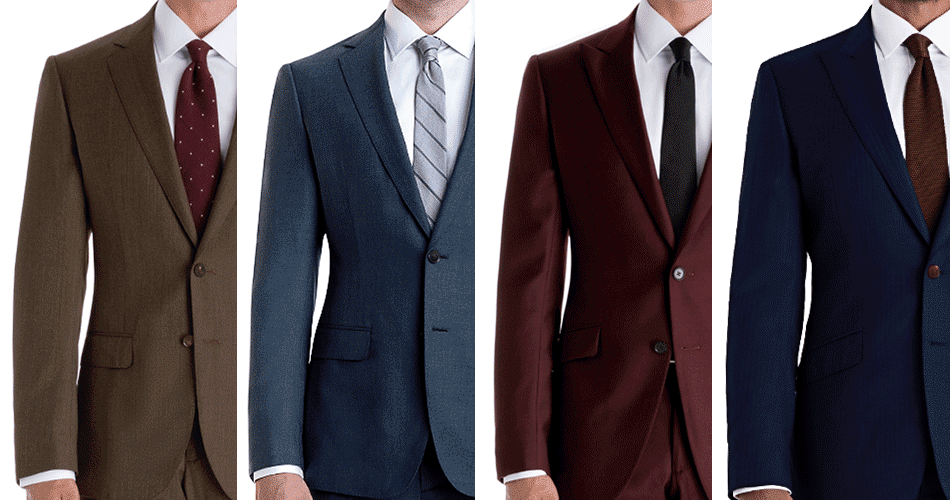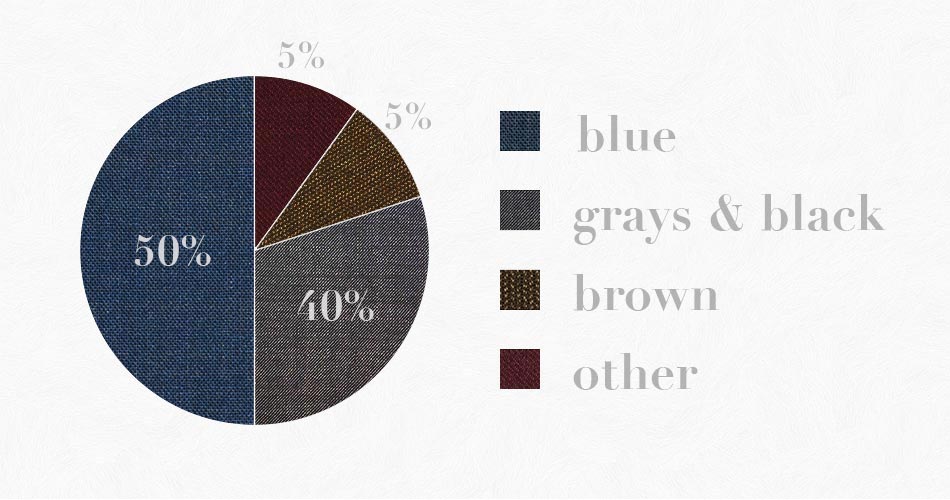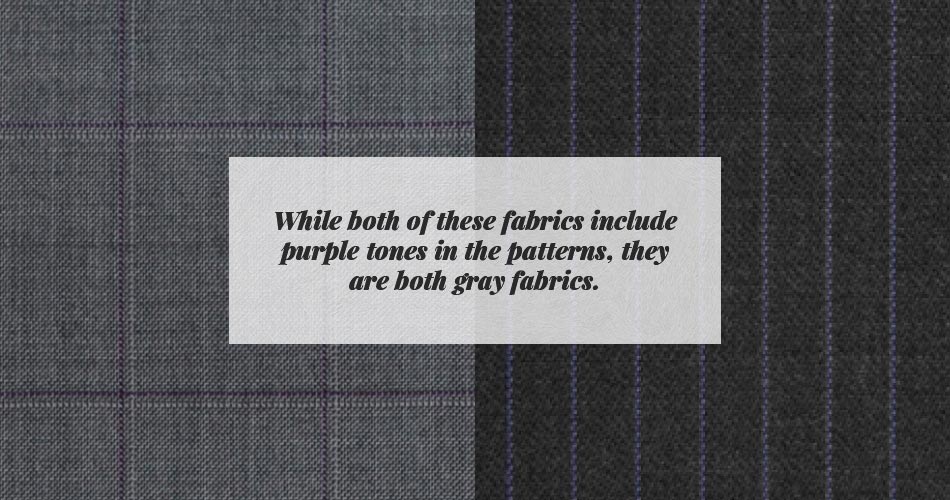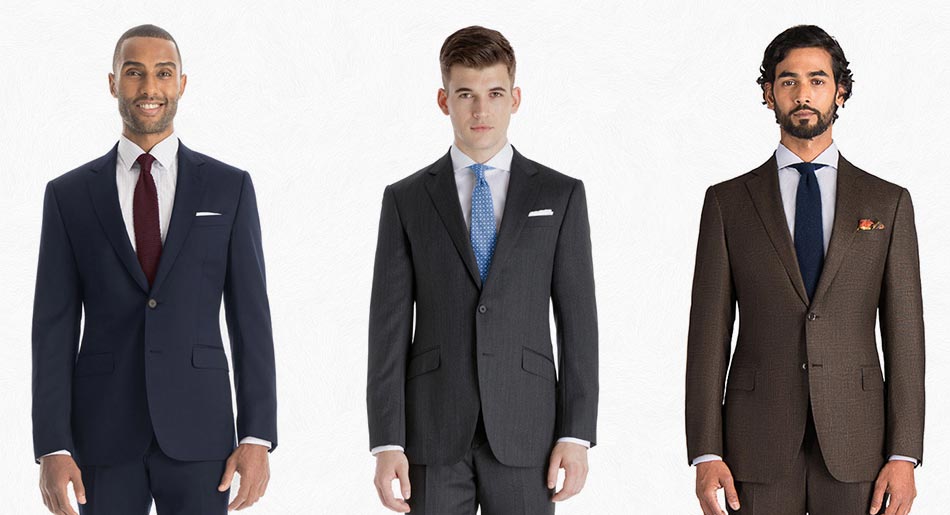Pick The Best Suit Colors For Your Wardrobe

Picking Suit Colors: The Basic Rules
There are so many choices when it comes to picking suit colors but when it comes down to it, there are three main categories: shades of blue, shades of gray (including black) and shades of brown. When building your suit wardrobe, you don’t want it to rely on the same routine color. This will make your day-to-day look boring and overly routine. On the other hand, you don’t want to fill your wardrobe exclusively with vibrant, exuberant colors. While it is okay to wear these overtly stylish suits from time-to-time, in most cases the dress-code and context won’t allow it.
The Suit Color Breakdown
So, what suit colors should you be building into your wardrobe? We recommend a mix along the lines of the below chart. You can think of your suit collection in increments of five (a typical work week). The percentages below will apply best to a collection of 10 suits (we dig suits okay?) but feel free to round up or down based on your target number.

As you can see, we clearly favor blue. In fact, we recommend you deploy up to 50% of your suit collection to varying shades of blue, from a classic solid navy blue suit to a mid-range blue herringbone all the way to something spirited like a blue toned windowpane. Why do we love blue so much? For one, a navy blue suit is a great foundation piece. Second, it’s perfect for special occasions including wedding attire. Blue is extremely wedding friendly because it pairs well with most popular wedding colors and bridesmaid dresses of many shades. So, you not only have your foundation piece, but you have a suit that can be utilized in multiple situations. It’s universally appropriate, and for guys reading this post feeling a bit overwhelmed because you’ve yet to purchase your first suit, the navy blue suit should be your first.
After blue, you will want to make sure you have a healthy stock of gray suits, and at least one black suit. This is because just like navy, gray and black suits are foundation pieces. For the men who work in strict business-formal offices, gray suits fit the dress criteria perfectly and are a neutral palette on which you can style virtually any colored shirt and tie combination. And in regards to having a black suit in your arsenal, there will be solemn occasions in life when the dress code calls for a black suit, so make sure you are prepared.
Lastly, your suit wardrobe can have some character too. A brown suit can elevate your suit game and help break the monotony of the navy and gray rotation (oh, and it’s easy to wear, too). And if you really want to add some zest, you can opt for a more colorful suit like olive green or burgundy. However, we would always recommend you build your wardrobe around foundation blue and gray pieces first.
As you’ve probably already noticed, the rules of dress codes have been changing as of late, but the rules for building a collection of suit colors that will have you sharply dressed in any occasion still remain the same.
Rules of Thumb For Picking the Best Suit Colors
Rule #1 – Always pair your suits & your hair

This is the number one rule for a reason. This rule yields great results. But interpreting this rule is the trick. It DOES NOT mean that if you have brown hair you must wear only brown suits. Instead, focus on matching your hair’s shade to your suit’s shade. If you’ve got dark hair, dark suit colors naturally frame your face and will look better on you than someone with light hair. It also doesn’t mean you can’t wear lighter shades – only that darker ones will look better on you in comparison. So if you’ve got dark brown hair, a dark brown suit will work best for you, but so will a dark gray suit or a dark blue suit. The key word is dark.
Rule #2 – Go in order

As we covered above, when you are first building a wardrobe, start with foundation colors like the classic blues and grays. As you build, push further toward the edges with less expected colors.
Rule #3 – Play to the base

This advice isn’t just for politicians. When considering patterned fabrics, many men get hung up on the fact that there are multiple colors in the fabric when all you need to focus on is the base color. A gray plaid suit is still, all-in-all, a gray suit. Does the windowpane pick up the blue on your eyes? Great. The pinstripe hue is in your favorite color? Perfect. But there is almost always one dominant color in a fabric. That’s the one to focus on when you’re building your collection.
Rule #4 – Don’t overthink it
Remember a suit is just one ingredient in the dish called an outfit. Your choices in shirt colors and accessories like ties, pocket squares and socks can all take their chromatic cues from your suit colors. So the simpler your palette, the easier it is to dress well.
Our Favorites:
Now that you know how to pick your suit colors accordingly, here are our favorite suits inspired by the rules.

Pictured here: Rivington Dusk Blue Suit, Light Gray Herringbone Suit, and Rust Brown Suit by Black Lapel

Pictured here: Navy Blue Suit, Rivington Gray Suit, and Brown Glen Plaid Suit by Black Lapel
Your Next Move:
Like What You See? There's More.
We'll send you style advice and intel for the modern man.




Don’t forget fabric weight and texture. Color is just the beginning.
Black tone skin, what colour you can suggest
Single mom here with a teen son who couldn’t care less about style but needs a suit. Thank you SO MUCH for this article. Now to help with matching ties/shirts… 🙂
Anyone still making color on color suits? Navy blue or black.
What color is best for black or Asian men and older men with all white or grey hair?
What if I’m not male model thin and built? What if I’m built like 99% of American men?. What about a suit style for the typical man?
I’m 66, and for the first time ever, have needed to buy a suit. (No, not for a funeral.) One of the many things the salesman talked about was matching the jackets to my skin tone. Apparently that’s why I have one each of very dark blue and extremely dark blue.
My wife & I are going to more events where a suit is more appropriate than a tee shirt, so I’m looking to add to my wardrobe. How to find out about matching skin/hair/suit colors? Well, everything’s on the Net.
I found your article talking about suit colors, matched with hair and skin, and read it carefully. Twice. It doesn’t talk about me.
I have fair skin with freckles (Norwegian/Irish). I have two tones, pale, or been-in-the-sun-too-long. I used to be a redhead, and my skin reflects that. But things change. No more red. My head is shiny on top, with white all around the sides and back.
Are very and extremely dark blues my only options? Really?
Hey Tom! We hope you’re enjoying your foray into suiting! So let’s state that while we write suiting advice, these are not to be interpreted as solid rules that you have to follow.
We would always advise you have a dark blue/charcoal suit on hand just because it works so well with other combinations, but after that, explore what you think looks good on you, because how you feel in your suit is what matters at the end of the day.
What about men with red hair?
You do realize that your pie chart is 110% right?
Ah… yes! Of course, we knew this! Funny… now it seems to add up to 100%…
What about neon orange?
We’d recommend you save that as a party suit 🙂
what about for salt-pepper hair color??
Hey Ken!
Salt & pepper hair is easy to work with! It’s actually pretty simple. Depending on the ratio of salt-to-pepper, your light gray suits and dark gray suits are going to play to both tones in the best ways. Navy suits will also always be a good option, as long as you keep in mind the salt-to-pepper ratio.
Matching one’s suit to one’s hair in certainly a sound principle, but where should bald guys take their colour cute from? Hopefully not a 1970s Telly Savalas “Kojak” safari suit in off-white!
LOL. Definitely not—Kojak’s style is all his own. Although now that we think about it, that would be an excellent Halloween costume.
Anyways…bald men should take cues from their skin tone and eye color. If your skin and eyes are both light, stay away from really dark, saturated suit colors. If your skin and eyes are both dark, the opposite is true. If your cues are mixed (dark skin and light eyes or light skin and dark eyes), you have a bit more wiggle room. That being said, we recommend you still stay away from stark contrast.
It’s interesting that this excellent article implicitly reinforces the message which many of us have learnt through making an expensive mistake – namely that a black suit is easy to buy, and very difficult to wear.
Preach! We steer guys away from the black suit on the regular, so we’re glad you already know better. Thanks for reading.
Great update on your old “Pick suit colors that match you” post.
Sounds like you’ve been checking out The Compass for a while, Gilbert. We’re happy we can help.